FAQ
- Bolivia climbing questions
-
Mallorca island and rockclimbing
- What are main specifics of rockclimbing trip to Mallorca
- Mallorca island impressions
- Rockclimbing safety Spain
- Mallorca climbing accommodation
- What season is possible for rockclimbing in Mallorca
- Transport accessibility of climbing sectors in Mallorca
- Active vacation in Mallorca
- Saint Anthony night in Mallorca
- Peru climbing questions
- Gear reviews
-
Safety in the mountains
- How NOT to climb the summit?
- Mountain navigation
- At the limit of possibilities
- Mountain thunderstorm
- Solo ascents and mountain trips alone
- Mutual responsibility in mountaineering
- Safety illusions in the mountains - a rope
- Independent team of two
- Mountain troubles
- Psychological problems in the mountains
- Health in the mountains
-
Elbrus questions
- Elbrus climbing gear
- Climbing Elbrus with children?
- Mount Elbrus location?
- Elbrus logistics
- How to get to Mount Elbrus?
- Elbrus German airfield?
- Elbrus difficulty grade
- 5 points beginner must know about Elbrus
- How to prepare for Elbrus?
- Are there avalanches on Mount Elbrus?
- Climbing Elbrus solo?
- Seasonality of climbing Mount Elbrus
- How much time climbing Elbrus takes?
- Clothes for Mount Elbrus?
- Pressure at the top of Elbrus?
- Elbrus air temperature
- Elbrus sightseeing
- How much to climb Elbrus
- Gear questions
- Mountaineering questions
- Mountain climbing training
-
Rockclimbing questions
- Rockclimbing gear
- How to choose your first rockclimbing shoes
- The hand power in roclcimbing
- What is Rockclimbing tours
- Non olymnic rockclimbing
- What is rockclimbing?
- Where do you climb?
- Where and when we organize our rockclimbing programs?
- What is rockclimbing?
- Rockcliming program class?
- Climbing motivation
- Horse riding tours
- Iceclimbing questions
-
Questions on the alpine programs
- What to climb in Morocco?
- Weekend summit climb
- Georgia 2023
- Pico Aneto - what is that mountain?
- Mountain programs format
- Mountain climbing food ration
- Queries on the alpine program climbing Mount Bazarduzu
- Queries on the Kamchatka alpine program climbing
- What is combined program?
- What is sightseeing program?
- What is pilot program?
- What programs you have of the medium complexity level?
- Basic expedition rations
- Prices for the mountain climbing programs
- Queries on the Mountain Course in Adyl Su valley
- Program complexity?
- Questions about MCS AlexClimb
- Questions related to trekking programs
Mountain climbing food
Read in Telegram in English
Leer en Telegram en Español
MCS AlexClimb Mountain Climbing School
General issues of nutrition and the formation of food layouts when organizing mountain expeditions and ascents
Traditionally, one of the most important stages of preparing for a mountain trip or climb is drawing up a nutrition schedule and selecting special food. I still remember those times when, before going to the mountains, we dried bread, cooked dried meat in the oven, and filled honey and nuts into plastic bottles - these time are gone.
From a distance the mountains always look so close. Caucasus, Bezengi Gorge. Mount Koshtan and Dykh Tau summit
Progress does not stand still, and now the main difficulty is not the absence of something, but the abundance of opportunities and the breadth of the range of available outdoor food products.
In this text, I want to offer you a series of theses about nutrition in the mountains, based on my own 25 years experience as a guide on mountaineering climbs of varying duration and complexity.
Perhaps my theses will seem controversial to someone, but they are certainly useful, like any well-founded and professional point of view.
There is always food in the mountains. But it's not always easy to eat it
I must warn that you will not find ready-made solutions for food layout in this text, since they do not exist. I will formulate only the basic principles and recommendations on the topic of nutrition in the mountains, which can help you prepare for your mountain route.

Formation of an individual food layout before setting out on the route to climb Mount Gestola, Caucasus
Let's look at the following questions regarding nutrition during mountain climbs:
· Specialties of nutrition during mountain programs and alpine ascents
· Hot or cold food?
· Do you need a thermos for the alpine ascent?
· Are army packed rations suitable for mountaineering?
· Are there ready-made solutions to the issue of food layout for mountaineering - what products to buy?
· Alcohol in a mountaineering layout
------------------------------------------------------------
The first important feature of mountaineering as an activity is the critically high level of short-term, peak loads on the body.
Climbing Klyuchevskaya Sopka in Kamchatka - 12 hours of continuous push on the summit from a level of 2900 m
During ascents, we expose our body to a very high load; it is impossible to compensate the energy consumption with nutrition at the same time, no matter what products we stock up on.
Climbing even on the initial difficulty can cost more than 10,000 calories per day - such a loss of energy cannot be compensated for by any nutrition - we can not eat that much. And even if we could, we won’t digest it...
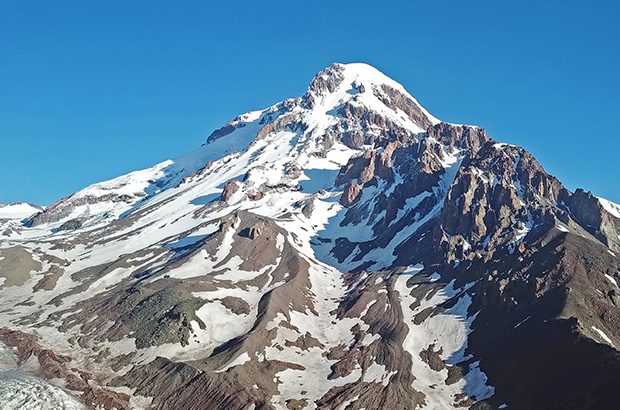
Climbing Mount Kazbek - you can climb this mountain in 2-3 days, fueled by dreams of delicious khinkali - you can smell the next photo, their aroma is unique
Our body is a well tuned computer that perfectly understands and can calculate how much energy it needs at the moment and how much power it will spend on extracting this energy from certain products.
If the proportion seems unfavorable to the body, then it can refuse to take external food and use its inner reserves.
The process of redistributing energy and turning on resources is an automatic reaction of our body to extreme environmental conditions, part of the general process of adaptation to stressful load.
Khinkali is one of the unobvious but terrible dangers of Georgia - they penetrate into the stomach too easily...
Of course, this process does not always go smoothly - there are quite a few factors that complicate our life in the mountains, and the issue of nutrition is only a small part of the overall picture.
Do not forget that while staying at high altitudes, the load on the body and energy consumption continue even in a state of conditional rest. Even during sleep, our energy goes into adapting to the lack of oxygen, unusual external conditions and physical activity schedule.
Mosquitoes in Kamchatka never lose their appetite
Many climbers have noticed the effect of loss of appetite during acclimatization in the mountains. In the first days of the alpine route, the body does not want or even refuses to take food.
This is a completely normal, natural reaction of our body, which understands that it will spend more energy digesting food than it will receive in return.
You should not force food intake in such a state - this can lead to unpleasant or painful consequences - stomach upset and even greater loss of energy. The recommendation is simple - listen to your body's reaction - it may well tell you which products and in what quantities it needs at the current moment - or does not need it at all.
If you want to eat a cricket or a cockroach, it means your body has need of it
Such an approach, especially at high altitudes, requires experience and caution - the fine line between painful acclimatization and pathological reaction to altitude is difficult to determine, especially in case of lack of the necessary experience.
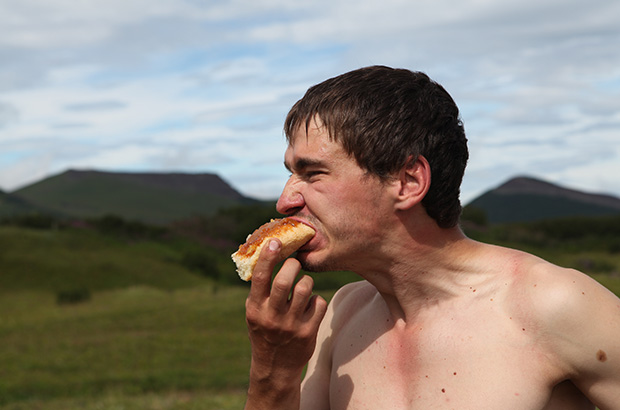
Under the influence of altitude in the mountains, sometimes even attacks of cannibalism occur
----------------------------------------------------------------
Here is an example from my experience as a mountain guide:
We climbed Mount Huascaran Sur - the highest mountain in Peru, almost 7000 m high. Having good acclimatization, we decided to climb the summit in the easiest and fastest format possible - in three days, completely independently - without porters and with a minimal food layout.
Nevado Huascaran in Peru 6746 m
The load in this format of mountain climb was so high that during the ascent the body did not require food at all - we did just with hot sweet tea and several cookies a day.
In case of a sudden need for calories, everyone had a couple of chocolates in his pocket - to get protected against the “glucose hole” (hypoglycemia) - this functional failure can be triggered by a critically high load even on a trained body - that is tested from my own experience.
The Huascaran climb was successful, and after the summit we immediately began to descent.

Ice summit of Nevado Huascaran
Going down, I physically felt the processes in my body being restarted - with every hundred meters of the lost altitude, I began to feel hunger more and more clearly. However, this hunger was quite selective - I remember very well my internal dialogue with my own stomach:
- Maybe we can eat beef steak? - no, he's too rude
- Then at least grilled chicken! - no, it's too dry
- Maybe a pork chop? - no, it's too fat
- What kind of whims?! What do you need, my dear stomach?! - I want cuy! (traditional dish in Peru, roasted guinea pig)
In this choice there was nothing surprising - it is guinea pig meat that has the best qualities for recovery after high-altitude load - it is tender, very light and nutritious.
Here it is - cuy - a traditional holiday dish in Peru
Due to its qualities, this dish is extremely popular among the people of the Peruvian and Bolivian highlands; among the Quechua Indians it is considered a delicacy.
---------------------------------------------------------------
The second obvious feature of the real mountaineering routes (I’m not talking about commercial programs, where quality food is part of the service) is that the entire set of products and means for their preparation must be transported independently - in the backpack.
At the same time, the energy consumption for carrying cargo in the altitude conditions can be many times greater than the energy value of the carried products.
Mountains are easy and accessible only in the pictures or on the top of your sofa with a TV remote control instead of an ice ax
For myself, I found the optimal solution to this issue: for the short alpine routes in the mountains - 1-4 days, I take a minimum set of basic dry food (dry weight 250-300 grams per day: nuts, honey, chocolate, dried fruits, dehydrated meat), the most important condition is the availability of plenty of sweet hot drinks: in my case, it’s tea with sugar and lemon.
I can comfortably survive on the climb for several days even at maximum physical load - I have climbed Mount Ushba and Dykh Tau in Caucasus more than once in this format.
Mount Ushba is the most beautiful and quite difficult for climbing mountain of the Caucasus
Longer routes in the mountains require an expanded range of food products - accumulating fatigue dictates more stringent requirements for recovering and renewal of energy.
-------------------------------------------------------
Another story from my practice.
Once I worked as a guide on Khan Tengri Peak, and had a client from Austria, the owner of a large restaurant business.
With well-known German pedantry, my client packed food into containers for all the days of high-altitude climbs.
The plastic boxes contained chocolate, biscuits, dried fruit, dehydrated turkey meat, energy bars, delicious Bavarian sausage and even a micro can of beer. In the Base Camp it all looked perfect, but...

Peak Khan Tengri, view from the top of Chapaev Peak - the classic route runs along the central ridge
After the ascent, almost the entire set of products was lowered to the Northern Inylchek BC and presented to me as a souvenir for the next expedition. The Austrian guy climbed to the summit using resources of his own body, two Snickers and my thermos of tea - he didn’t want dried fruit, the sausages made him sick, and the beer could only be sucked or licked - at an altitude of 6000 m it got frozen.
--------------------------------------------------------------
Summarizing this example, I can say that the thoughtless arrangement of high-altitude rations leads, among other things, to littering of the ascent routes - not all the teams have the opportunity or desire to lower the unused food remaining after the ascent.
Sorry for that picture... this is just a garbage left on the Lenin Peak classic route - in the altitude zone 5000+, where any garbage does not decompose at all
From the above, we can draw some conclusions:
- Nutrition on the climbing routes cannot fully compensate the energy expended in the moment. Effectively overcoming the load largely depends on the availability of body reserves. So you should not deliberately lose weight or go on a diet before going to the mountains.
- Meals during the climbing should be as easy as possible for the body to digest - liquid, warm and well prepared - in order to reduce the load on the stomach and energy expenditure on digestion.
- Food during the ascent should be ready to eat without additional cooking - the “pour boiling water over and wait 5 minutes” format.
It should be taken into account that the boiling point of water at an altitude of more than 4000 m is significantly lower than at sea level - many products (instant noodle or cereal porridge) are not completely brewed with boiling water and require several minutes of additional boiling.
For this reason, it is not recommended to use plastic pots while climbing - it is impossible to cook or heat food in them over an open fire.
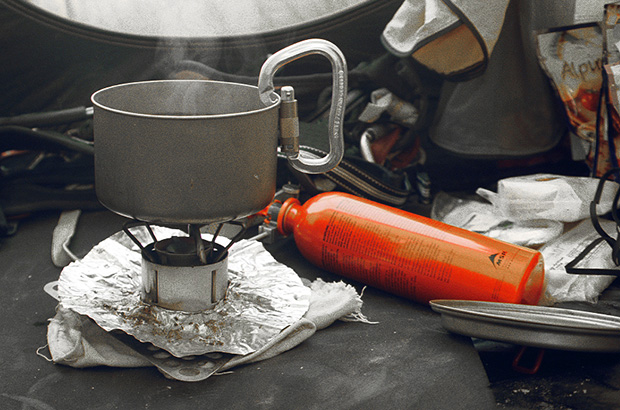
Cooking a standard instant ration at an altitude of 7000+ meters, climbing Peak Communism
- The food layout for climbing should be extremely compact and light in weight (dehydrated) - do not forget that we spend our own energy carrying the load.
- Ideally, the food layout should be adapted to the acclimatization schedule (in the case of a long climb or mountain expedition). In the first days of high-altitude load, the need for food will be lower than at later stages of the route.
- In the mountains you can eat everything, even what many are forced to give up on the plains - for example, flour and sweets. Sweets are the easiest energy to absorb. Chocolate, honey, jam should be in any food layout for the alpine ascent.
Hot or cold food?
When it comes to saving the weight of climbing equipment, sooner or later a thought comes to mind: is it possible to completely abandon bulky and heavy equipment for heating food - burners and gas cylinders?
Is it possible to stay in the mountains without hot food, to live for a short time solely on stream water and dry foods?
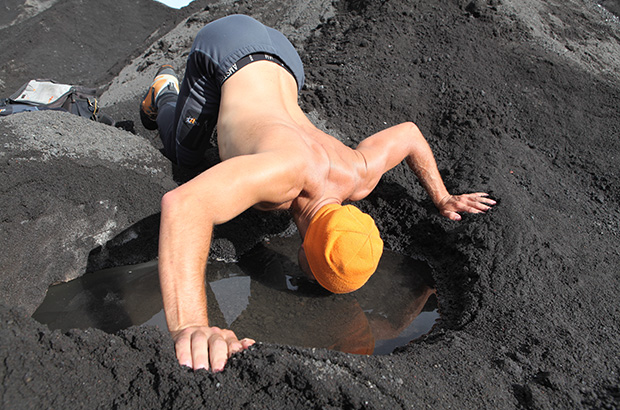
It is quite safe to drink fresh water in the mountains, but definitely it is better to boil it
I experimented with this format of ascents (of course, up to the snow zone) and came to the conclusion that this idea was inappropriate. Of course, to leave in the car the kitchen equipment is very tempting in terms of reducing the overall weight of the carried equipment. But this weight saving comes to an additional noticeable loss of energy.
The fact is that in order to fully assimilate the food our body needs to heat (or cool) it to this body temperature. The process consumes a lot of energy. If there is a noticeable deficit and high energy consumption on a mountain route, drinking cold water from a stream and consuming unheated food can be critical in terms of energy loss or even hazardous to health.
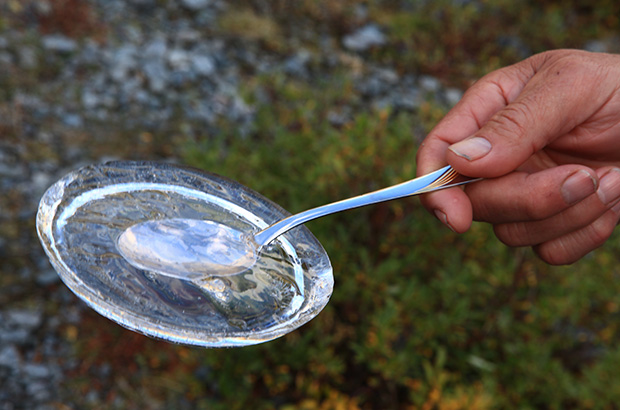
Sometimes in the mountains all you need is just a cup of hot coffee for your breakfast
The above also applies to the frequent question of whether is it worth taking a thermo bottle for a climbing route. Not all mountain guides answer this question unambiguously. Sometimes I myself, after checking the weight of the packed backpack, decide to replace the thermos with a lighter plastic bottle...
However, having a hot, sweet drink can be extremely useful on the mountain, especially in case of delays along the route or any unexpected situation.
Having assessed the weight and volume of the backpack, we often come back to the question: what is the reason for our going to the mountains?
Therefore, about a thermos, the answer is more likely yes than no. A light, possibly titanium liter flask with hot sweet tea can significantly facilitate a climber’s survival on the route. And in a critical situation it even can save lives.
Military food ration
When working on the food layouts for the ascents, I often deal with various military dry rations - both Russian and foreign. With many similar parameters, the realizing of army food rations largely does not meet the nutritional requirements for mountaineering.

Russian military food pack - the best that can be said about this food box is that after unpacking and using it, a bunch of garbage can be seen even from space.
Let's figure out what army food rations are generally intended for. First of all, this is a standard set of products to provide food for soldiers when it is impossible to organize a field kitchen - in a dugout, in a trench, etc.
Army food rations are not intended for autonomous forced marches - for this they are too heavy and bulky - for use on the independent route they must be re-equipped and freed from all unnecessary things.
After re-equipment, (if there is anything useful left), the army food ration can be relatively suitable for use on the autonomous routes and alpine ascents.
After all, mountains are food for the soul, not for the stomach
Ready-made food layout solutions and outdoor food industry
There are no ready-made food layouts solutions for mountaineering.
The fact is that the set of food for climbing must correspond to the specifics of the route, its timing, climbing tactics and the group training level. Of course, the set of products will be different when climbing trekking alpine route, for example, to Mount Elbrus or to big-wall climb of Fitz Roy or El Capitan.

Big Wall climb of El Capitan, USA
However, there are many options for composing the mountain climbing food layout.
All over the world, for a while there is a developed industry of outdoor food products specifically designed for use in various types of outdoor activities. As a rule, these are packaged rations, either ready-to-eat or not requiring a long preparation time.
It should be noted that with all the abundance of choice, offers in the narrow format of mountaineering practically do not exist on the outdoor food market - this segment is too small and of little interest to the manufacturers.
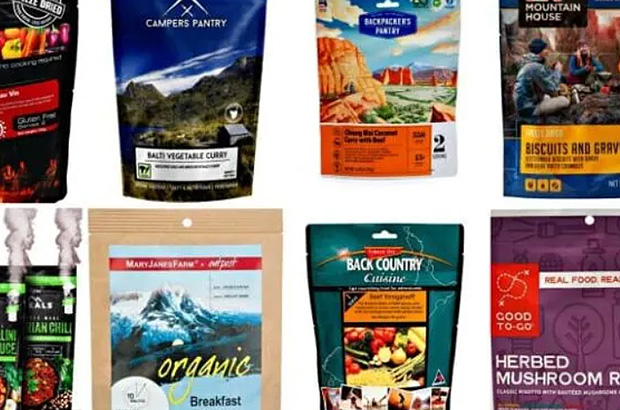
Still there is no expedition in which you could taste the entire collection of delicious outdoor food
The main audience of the outdoor food market is hiking and trekking enthusiasts, fishermen, hunters, and tourists making easy hiking trips lasting 2-5 days.
In this format, the food manufacturer pays great attention not so much to the ratio of energy value and weight of the product. The most attention is paid the taste and gastronomic appeal. This marketing approach in civilized countries is reflected even in the segment of military food rations.
By chance once I got several sets of the US Army military rations - the standard version included 30 (!) sets of various foods of the high quality, well-thought-out assembling and packaging.
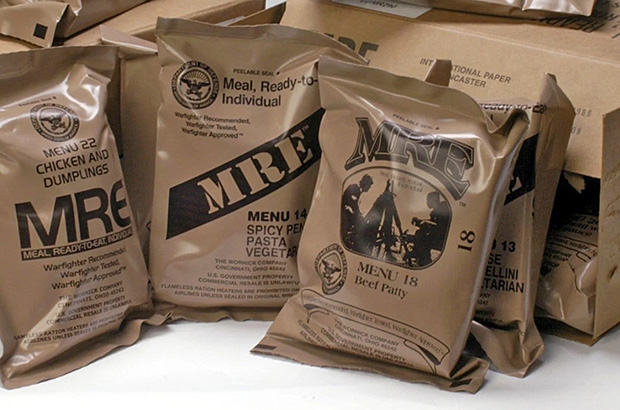
Just high quality and thoughtfully prepared camping food
So, in the broad outdoor food market segment, menu variety takes precedence over the weight and method of preparation.
You can agree that eating a variety of tasty food not only physically supports a tourist, hunter, or a soldier in unusual or difficult conditions, but also relieves stress and psychological frustration, creating a feeling of “home care”.
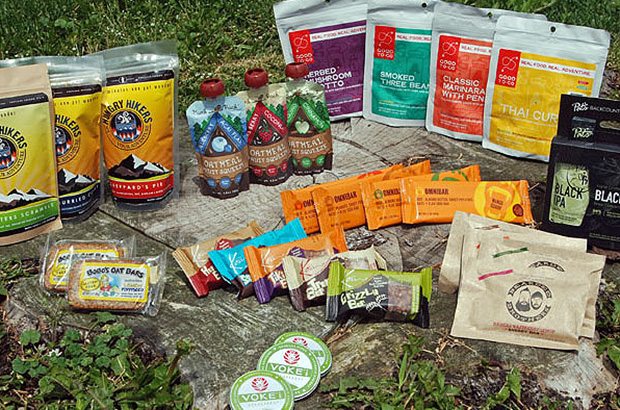
Having all that food you don't even need to go to the mountains
Modern portioned outdoor packages offer the highest quality and variety of ready-made food, ranging from dishes from various grains - rice, wheat, beans, to outright gastronomic masterpieces of the national cuisine of different countries - this is especially typical of Chinese and Korean producers.
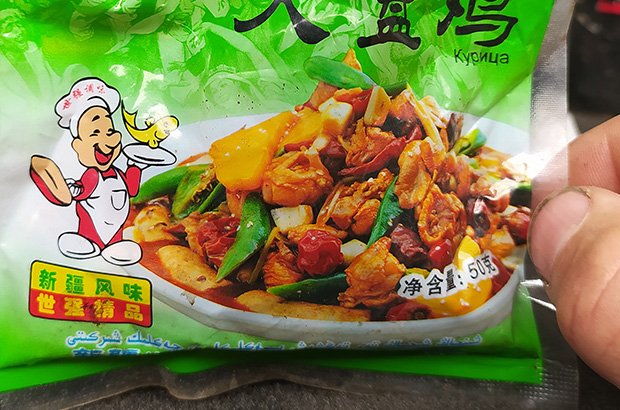
Chinese products are top notch as usual - in every sense
The competition of manufacturers in the international outdoor food market is very high: one can endlessly list the various brands and products, the range of which is updated every day.
The outdoor food market is especially well developed in countries with a high culture of outdoor activities - Europe, the USA and Canada are clearly leaders in this field.
Alcohol in the mountaineering food layout
In the conditions of critical energy consumption during an alpine ascent, the need for constant physical and psychological mobilization of all the body's resources, any additional load can lead to loss of energy and functional failure.
The only benefit of alcohol in the mountains is that you can get drunk to a hard hangover and make your guides happy, changing your mind about climbing to the summit
Drinking alcohol on a mountain climbing route creates unjustified risks. For this reason, I recommend to avoid any alcohol consumption on any, even the simplest mountaineering routes.
----------------------------------------------------------------
If your goal in the mountains is the Summit, in order to achieve it, it is worth to endure some of the inconveniences of a meager food supply. But after the descent, in a good restaurant and good company of your climbing friends, you can celebrate your success and reward yourself for all the mountain hardships.
Coming down from the mountains - overeating is unlikely to be avoided
The author of the text and photos - Alex Trubachev
Your professional international mountain guide and climbing coach
MCS EDIT 2024
Our Principles
AlexClimb Rule #1 - Safety First
From the very beginning of our activity, here nearly 16 years, the first Principle of work of School of mountaineering and rock-climbing of MCS AlexClimb is the Safety Priority. On the basis of this Principle all process of training is based, all programs and rounds are developed and carried out only within this main principle. We consider that at professional approach to development of programs, at personal discipline and correctly put motivation - occupations by mountaineering and rock-climbing are COMPLETELY safe. And from the return - all troubles and accidents in our sport come from nonprofessionalism, from ignorance or neglect by elementary standards of safety, from irrational motivation, from revaluation of own forces and opportunities. All these prerequisites we COMPLETELY EXCLUDE in our work - ours Rock-climbing, Ice climbing and Mountaineering are based on one Principle - the Safety Priority. In rock-climbing, mountaineering and ice climbing, the Priority of Safety of MCS AlexClimb-is your personal security and comfort irrespective of, than we are engaged - we train muscles and we work technology of the movement in the sports hall and on the rock climbing wall, we make the way through snowstorm to top or we relax on golden sand of the Caribbean beach after hot day of trainings on rocks. The Safety priority - the main credo of School of mountaineering and rock-climbing of MCS AlexClimb.
AlexClimb Rule #2 - Leave No Trace
Closely interacting with Nature, working with the active programs in mountains, woods, lakes and rivers, we perfectly understand the importance of carefull and respectfull bahavior towards the Nature, for its resources. From the very beginning of our outdoor-activity we adopted rules of Leave No Trace technique - the standard of behavior of the person accepted in all the civilized world in relation to environment and especially - to the wild nature. After all on the relation of people to the nature near which they exist, itself can draw dalekoidushchy conclusions on the relation of these people to... Where and as we didn't travel - we don't reserve any garbage, we try to reduce whenever possible our influence on environment to a minimum. We clear earlier zagryazyonny tourist parking of the left garbage, we take out and we take out to utilization places that to us other people left there. We consider that only thus, at personal individual consciousness of each citizen, each tourist, climber or autotraveller, we will be able to keep the nature surrounding us in its state, natural, suitable for life, - in it pledge of the healthy future for ourselves and our children.





